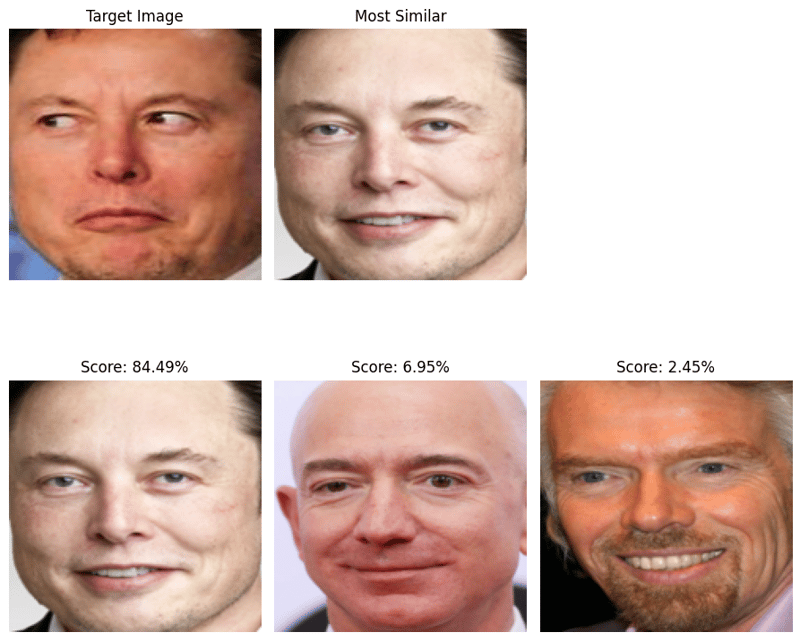Python と FaceNet による顔認識
このガイドでは、facenet-pytorch を使用した顔の類似性検出ツールを説明します。このツールは、FaceNet モデルの高品質の顔埋め込みを利用して、ターゲット画像を複数の候補と比較して、最も近いものを特定します。 実装を見てみましょう。
必須のツールとライブラリ
- PyTorch: 深層学習操作の基盤。
- FaceNet-PyTorch: 顔検出と埋め込み生成用の事前トレーニング済みモデルを提供します。
- 枕 (PIL): 画像操作タスクを処理します。
- Matplotlib: 結果の視覚化に使用されます。
2 つのコア モデルが採用されています:
- MTCNN: 画像内の顔を検出します。
- InceptionResnetV1: 顔の埋め込みを抽出します。
初期化
import torch from facenet_pytorch import MTCNN, InceptionResnetV1 from PIL import Image import requests from io import BytesIO import matplotlib.pyplot as plt # Initialize face detection (MTCNN) and embedding extraction (InceptionResnetV1) modules. mtcnn = MTCNN(image_size=160, keep_all=True) resnet = InceptionResnetV1(pretrained='vggface2').eval()
関数の定義
1.画像の読み込みと埋め込み抽出:
この関数は、URL から画像を取得し、顔を検出し、埋め込みを計算します。
def get_embedding_and_face(image_path):
"""Loads an image, detects faces, and returns the embedding and detected face."""
try:
response = requests.get(image_path)
response.raise_for_status()
content_type = response.headers.get('Content-Type')
if 'image' not in content_type:
raise ValueError(f"Invalid image URL: {content_type}")
image = Image.open(BytesIO(response.content)).convert("RGB")
except Exception as e:
print(f"Image loading error from {image_path}: {e}")
return None, None
faces, probs = mtcnn(image, return_prob=True)
if faces is None or len(faces) == 0:
return None, None
embedding = resnet(faces[0].unsqueeze(0))
return embedding, faces[0]2.テンソルから画像への変換:
表示用にテンソルを準備します。
def tensor_to_image(tensor):
"""Converts a normalized tensor to a displayable image array."""
image = tensor.permute(1, 2, 0).detach().numpy()
image = (image - image.min()) / (image.max() - image.min())
image = (image * 255).astype('uint8')
return image3.最も似ている顔の識別:
ターゲット画像の埋め込みを候補の埋め込みと比較します。
def find_most_similar(target_image_path, candidate_image_paths):
"""Identifies the most similar image to the target from a list of candidates."""
target_emb, target_face = get_embedding_and_face(target_image_path)
if target_emb is None:
raise ValueError("No face detected in the target image.")
highest_similarity = float('-inf')
most_similar_face = None
most_similar_image_path = None
candidate_faces = []
similarities = []
for candidate_image_path in candidate_image_paths:
candidate_emb, candidate_face = get_embedding_and_face(candidate_image_path)
if candidate_emb is None:
similarities.append(None)
candidate_faces.append(None)
continue
similarity = torch.nn.functional.cosine_similarity(target_emb, candidate_emb).item()
similarities.append(similarity)
candidate_faces.append(candidate_face)
if similarity > highest_similarity:
highest_similarity = similarity
most_similar_face = candidate_face
most_similar_image_path = candidate_image_path
# Visualization
plt.figure(figsize=(12, 8))
# Display target image
plt.subplot(2, len(candidate_image_paths) + 1, 1)
plt.imshow(tensor_to_image(target_face))
plt.title("Target Image")
plt.axis("off")
# Display most similar image
if most_similar_face is not None:
plt.subplot(2, len(candidate_image_paths) + 1, 2)
plt.imshow(tensor_to_image(most_similar_face))
plt.title("Most Similar")
plt.axis("off")
# Display all candidates with similarity scores
for idx, (candidate_face, similarity) in enumerate(zip(candidate_faces, similarities)):
plt.subplot(2, len(candidate_image_paths) + 1, idx + len(candidate_image_paths) + 2)
if candidate_face is not None:
plt.imshow(tensor_to_image(candidate_face))
plt.title(f"Score: {similarity * 100:.2f}%")
else:
plt.title("No Face Detected")
plt.axis("off")
plt.tight_layout()
plt.show()
if most_similar_image_path is None:
raise ValueError("No faces detected in candidate images.")
return most_similar_image_path, highest_similarity使用法
比較用の画像 URL:
image_url_target = 'https://d1mnxluw9mpf9w.cloudfront.net/media/7588/4x3/1200.jpg'
candidate_image_urls = [
'https://beyondthesinglestory.wordpress.com/wp-content/uploads/2021/04/elon_musk_royal_society_crop1.jpg',
'https://cdn.britannica.com/56/199056-050-CCC44482/Jeff-Bezos-2017.jpg',
'https://cdn.britannica.com/45/188745-050-7B822E21/Richard-Branson-2003.jpg'
]
most_similar_image, similarity_score = find_most_similar(image_url_target, candidate_image_urls)
print(f"Most similar image: {most_similar_image}")
print(f"Similarity score: {similarity_score * 100:.2f}%")結果

結論
この例では、facenet-pytorch の顔認識機能を紹介します。 顔検出と埋め込み生成を組み合わせることで、本人確認やコンテンツ フィルタリングなど、さまざまなアプリケーション用のツールを作成できます。
以上がPython と FaceNet による顔認識の詳細内容です。詳細については、PHP 中国語 Web サイトの他の関連記事を参照してください。

ホットAIツール

Undresser.AI Undress
リアルなヌード写真を作成する AI 搭載アプリ

AI Clothes Remover
写真から衣服を削除するオンライン AI ツール。

Undress AI Tool
脱衣画像を無料で

Clothoff.io
AI衣類リムーバー

Video Face Swap
完全無料の AI 顔交換ツールを使用して、あらゆるビデオの顔を簡単に交換できます。

人気の記事

ホットツール

メモ帳++7.3.1
使いやすく無料のコードエディター

SublimeText3 中国語版
中国語版、とても使いやすい

ゼンドスタジオ 13.0.1
強力な PHP 統合開発環境

ドリームウィーバー CS6
ビジュアル Web 開発ツール

SublimeText3 Mac版
神レベルのコード編集ソフト(SublimeText3)

ホットトピック
 1671
1671
 14
14
 1428
1428
 52
52
 1331
1331
 25
25
 1276
1276
 29
29
 1256
1256
 24
24
 Python vs. C:曲線と使いやすさの学習
Apr 19, 2025 am 12:20 AM
Python vs. C:曲線と使いやすさの学習
Apr 19, 2025 am 12:20 AM
Pythonは学習と使用が簡単ですが、Cはより強力ですが複雑です。 1。Python構文は簡潔で初心者に適しています。動的なタイピングと自動メモリ管理により、使いやすくなりますが、ランタイムエラーを引き起こす可能性があります。 2.Cは、高性能アプリケーションに適した低レベルの制御と高度な機能を提供しますが、学習しきい値が高く、手動メモリとタイプの安全管理が必要です。
 Pythonと時間:勉強時間を最大限に活用する
Apr 14, 2025 am 12:02 AM
Pythonと時間:勉強時間を最大限に活用する
Apr 14, 2025 am 12:02 AM
限られた時間でPythonの学習効率を最大化するには、PythonのDateTime、時間、およびスケジュールモジュールを使用できます。 1. DateTimeモジュールは、学習時間を記録および計画するために使用されます。 2。時間モジュールは、勉強と休息の時間を設定するのに役立ちます。 3.スケジュールモジュールは、毎週の学習タスクを自動的に配置します。
 Python vs. C:パフォーマンスと効率の探索
Apr 18, 2025 am 12:20 AM
Python vs. C:パフォーマンスと効率の探索
Apr 18, 2025 am 12:20 AM
Pythonは開発効率でCよりも優れていますが、Cは実行パフォーマンスが高くなっています。 1。Pythonの簡潔な構文とリッチライブラリは、開発効率を向上させます。 2.Cのコンピレーションタイプの特性とハードウェア制御により、実行パフォーマンスが向上します。選択を行うときは、プロジェクトのニーズに基づいて開発速度と実行効率を比較検討する必要があります。
 Pythonの学習:2時間の毎日の研究で十分ですか?
Apr 18, 2025 am 12:22 AM
Pythonの学習:2時間の毎日の研究で十分ですか?
Apr 18, 2025 am 12:22 AM
Pythonを1日2時間学ぶだけで十分ですか?それはあなたの目標と学習方法に依存します。 1)明確な学習計画を策定し、2)適切な学習リソースと方法を選択します。3)実践的な実践とレビューとレビューと統合を練習および統合し、統合すると、この期間中にPythonの基本的な知識と高度な機能を徐々に習得できます。
 Python vs. C:重要な違いを理解します
Apr 21, 2025 am 12:18 AM
Python vs. C:重要な違いを理解します
Apr 21, 2025 am 12:18 AM
PythonとCにはそれぞれ独自の利点があり、選択はプロジェクトの要件に基づいている必要があります。 1)Pythonは、簡潔な構文と動的タイピングのため、迅速な開発とデータ処理に適しています。 2)Cは、静的なタイピングと手動メモリ管理により、高性能およびシステムプログラミングに適しています。
 Python Standard Libraryの一部はどれですか:リストまたは配列はどれですか?
Apr 27, 2025 am 12:03 AM
Python Standard Libraryの一部はどれですか:リストまたは配列はどれですか?
Apr 27, 2025 am 12:03 AM
PythonListSarePartOfThestAndardarenot.liestareBuilting-in、versatile、forStoringCollectionsのpythonlistarepart。
 Python:自動化、スクリプト、およびタスク管理
Apr 16, 2025 am 12:14 AM
Python:自動化、スクリプト、およびタスク管理
Apr 16, 2025 am 12:14 AM
Pythonは、自動化、スクリプト、およびタスク管理に優れています。 1)自動化:OSやShutilなどの標準ライブラリを介してファイルバックアップが実現されます。 2)スクリプトの書き込み:Psutilライブラリを使用してシステムリソースを監視します。 3)タスク管理:スケジュールライブラリを使用してタスクをスケジュールします。 Pythonの使いやすさと豊富なライブラリサポートにより、これらの分野で優先ツールになります。
 科学コンピューティングのためのPython:詳細な外観
Apr 19, 2025 am 12:15 AM
科学コンピューティングのためのPython:詳細な外観
Apr 19, 2025 am 12:15 AM
科学コンピューティングにおけるPythonのアプリケーションには、データ分析、機械学習、数値シミュレーション、視覚化が含まれます。 1.numpyは、効率的な多次元配列と数学的関数を提供します。 2。ScipyはNumpy機能を拡張し、最適化と線形代数ツールを提供します。 3. Pandasは、データ処理と分析に使用されます。 4.matplotlibは、さまざまなグラフと視覚的な結果を生成するために使用されます。




